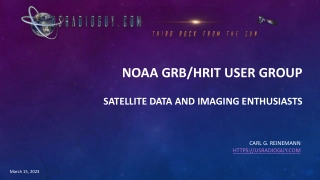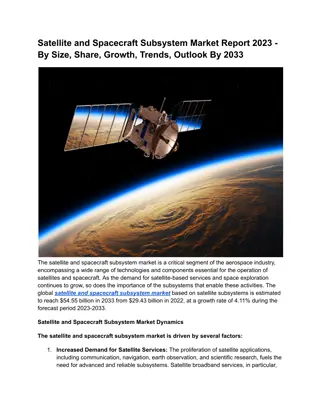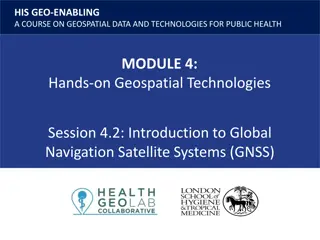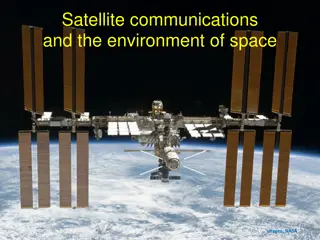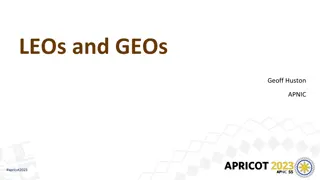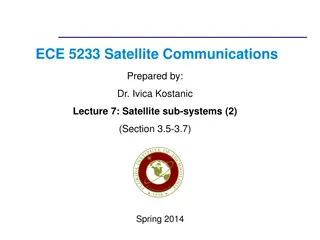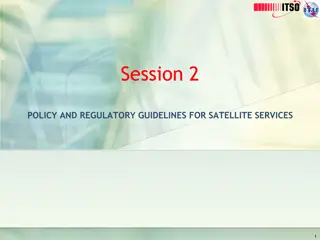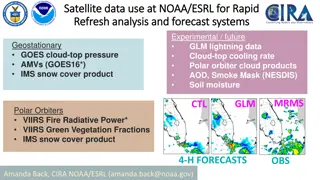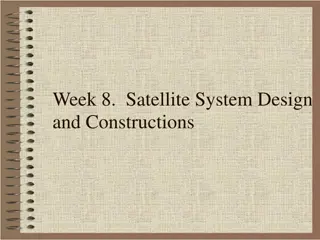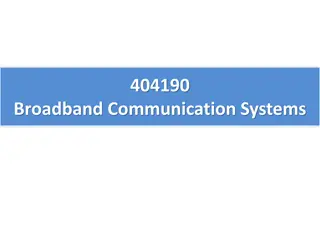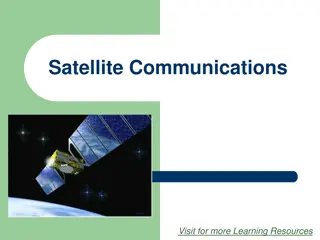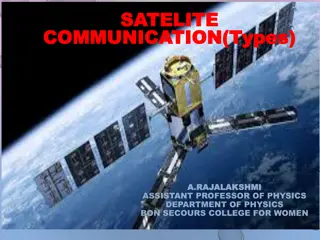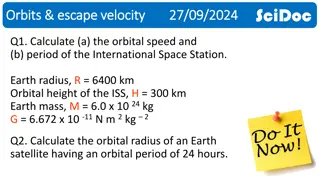International Regulatory Framework for Non-Geostationary Satellite Systems
Understanding the international regulatory framework for non-geostationary satellite systems, including coordination for protection of existing services, spectrum access/use laws, satellite frequencies and services, and mechanisms for protecting geostationary satellite orbits. The regulations aim to ensure fair access, prevent interference, and promote efficient use of orbital spectrum.
Download Presentation

Please find below an Image/Link to download the presentation.
The content on the website is provided AS IS for your information and personal use only. It may not be sold, licensed, or shared on other websites without obtaining consent from the author. Download presentation by click this link. If you encounter any issues during the download, it is possible that the publisher has removed the file from their server.
E N D
Presentation Transcript
25 May 2023 International regulatory framework for non- geostationary satellite systems Nelson Malaguti Timur Kadyrov International Telecommunication Union Radiocommunication Bureau
Legal Framework for Spectrum Access/Use United Nations Outer Space Treaty 1967 ITU is recognized as the specialized agency responsible for: Principles of use of orbit/spectrum Allocation of frequency bands Procedures, Plans, operational measures Instruments (Constitution CS, Convention CV, Radio Regulations RR, Rules of Procedures RoP, Recommendations Rec)
Non-GSO regulations Coordination ensures protection of existing services on equitable access basis Coordination between non-GSO and GSO in limited frequency bands (No. 9.12A) Coordination between non-GSO in limited frequency bands (No. 9.12) Coordination with terrestrial services under No. 9.14 List is given in Rule of Procedure under No. 9.11A 9.21 is also applicable if established in the footnote(s) Hard Limits Article 21 PFD limits to protect terrestrial services Article 22 EPFD limits to protect GSO from non-GSO BiU and post BiU procedures Article 11 Resolution 35 (WRC-19) Ultimate protection of GSO No. 22.2 Non-geostationary-satellite systems shall not cause unacceptable interference to and shall not claim protection from geostationary-satellite networks in the fixed-satellite service and the broadcasting- satellite service
Satellite Frequencies and Services L-band 1.0-2.0 GHz Mobile Satellite Service (MSS) Radionavigation Satellite Service S-band 2-4 GHz Radars, MSS, Broadcasting Satellite Space Research C-band 3.4-7 GHz Fixed Satellite Service (FSS), VSATs Direct-To-Home (DTH) X-band 7-10 GHz Radars, Satellite Imaging Space Research Ku-band 10-15 GHz FSS, VSAT Broadcasting Satellite, MSS Ka-band 17.7 - 21.2, 27.5 31 GHz FSS broadband , inter-satellite links, MSS Q/V - band 37.5 - 47 GHz, 42.5 51.4 GHz FSS broadband , inter-satellite links, MSS
Sharing situation for non-GSO - Protection of GSO - Protection of terrestrial services - Co-existence with other non-GSO
Protection of GSO P 10 ( ) d ( ) Two regulatory mechanisms EPFD hard-limits and coordination Technical solution for non-GSO is to avoid pointing antennas to GSO orbit or avoid operating satellite when there is insufficient separation angle between direction to non- GSO satellite and closest point on GSO when viewed from non-GSO earth station Equivalent power-flux density (EPFD) takes into account the aggregate of the emissions from all non-GSO satellites in the direction of any GSO earth station, taking into account the GSO antenna directivity N i a G G = i t i r i = 10 log 10 epfd 10 2 G 4 , r max i 1 S.1503-38 6 6
Red zone (low transmission level) is 20 degrees GSO arc avoidance in PFD Mask (will be changing with SSP latitude) SSP latitude 50
Protection of terrestrial services Hard-limits in Article 21 and coordination in Article 9 PFD Hard Limits (Article 21) EIRP Hard Limits (5.503, 21.13A etc.) Coordination threshold PFD
Coordination between non-GSO and GSO (9.12A, 9.21/A) and between non-GSOs (9.12, 9.21/B) Only frequency overlap is used to trigger coordination First-come first served basis
Technical challenges for LEO Coordination between non-GSO is complicated System design (orbit characteristics) may change during coordination process which may require restarting the coordination: Example, STEAM filings went through 3 different modifications of orbital parameters When operating in the same geographical area two system have only limited options for sharing No orbit separation or service area separation Limit operational parameters (restrict pointing directions, elevation angles) Divide spectrum access 10
Regulatory challenges How to enable efficient spectrum use for multiple LEO constellations? New challenges from direct-to-handset projects Frequency bands used for terrestrial mobile applications are not normally allocated to the satellite services Beyond ITU coordination Getting access to spectrum at national level 11
Agenda for WRC-23 Resolution 811 (WRC-19)
7: to consider possible changes, in response to Resolution 86 (Rev. Marrakesh, 2002) of the Plenipotentiary Conference, on advance publication, coordination, notification and recording procedures for frequency assignments pertaining to satellite networks, in accordance with Resolution 86 (Rev.WRC-07), in order to facilitate the rational, efficient and economical use of radio frequencies and any associated orbits, including the geostationary-satellite orbit
Topic A Tolerances for certain orbital characteristics of non-GSO space stations of the FSS, BSS or MSS Topic A for WRC-23 agenda item 7 considers the adoption of possible tolerances for certain orbital characteristics of non-GSO space stations of the FSS, MSS or BSS to account for potential differences between values recorded in the MIFR for the specified orbital characteristics of non-GSO space stations and those representative of the actual deployment of these non-GSO space stations. Any tolerances should provide the necessary flexibility to accommodate normal operations of non-GSO systems. The objective of these studies would be to determine the allowable differences between the values recorded in the MIFR and those representative of the actual deployment of these non-GSO space stations. Although studies have been conducted with a view to identifying allowable deviation/tolerance values for altitudes of apogee/perigee and inclination for a space station in a non-GSO notified orbit, there has been no definitive conclusion on an allowable limit for any of these parameters that would both provide certainty and not unnecessarily constrain efficient use of the orbital/spectrum resource by non-GSO systems.
Topic B Non-GSO bringing into use post-milestone procedure Topic B for WRC-23 agenda item 7 considers the possible adoption of a procedure to apply in cases where a non-GSO system subject to the milestone procedure in Resolution 35 (WRC-19) has completed the milestone procedure, but subsequently experiences a sustained reduction in the number of space stations deployed and capable of transmitting/receiving the assigned frequencies. When developing a post-milestone procedure, some degree of operational flexibility which is necessary for the maintenance of non-GSO systems in the FSS, BSS and MSS, needs to be duly considered. One of the main motivations for developing Resolution 35 (WRC-19) was to find a way to ensure that the content of the MIFR for non-GSO systems closely aligns with what is actually deployed in space, particularly for very large constellations of non-GSO systems. After the last milestone is reached, the requirement remains to have the number of satellites deployed and capable of transmitting or receiving the recorded frequency assignments correspond to the number of satellites in the recorded frequency assignments for the entire duration of their recording in the MIFR. A post-milestone procedure could give administrations more flexibility and certainty to operate non-GSO satellite systems that are subject to Resolution 35 (WRC-19) and have completed the milestone procedure, and then suffer a decrease in the number of deployed satellites.
Topic A Tolerances for certain orbital characteristics of non-GSO space stations of the FSS, BSS or MSS The allowed variation for the altitude ( altAllowed) of a non-GSO satellite is equal to: altAllowed = X in kilometres Where X is a fixed value equal to TBD The allowed variation for the inclination ( iAllowed) of a non-GSO satellite is equal to: iAllowed = Z in degrees Where Z is a fixed value equal to TBD Topic B Non-GSO bringing into use post-milestone procedure Develop the post milestone procedure in a new Resolution, based on similar regulatory mechanisms as in RR No. 11.49 and Resolution 35(WRC-19), which allows a certain reduction in the number of satellites deployed (e.g. 5%) for a maximum period of 3 years without changing the number of satellites recorded in the MIFR.
Thank you! ITU Radiocommunication Bureau Questions to brmail@itu.int




